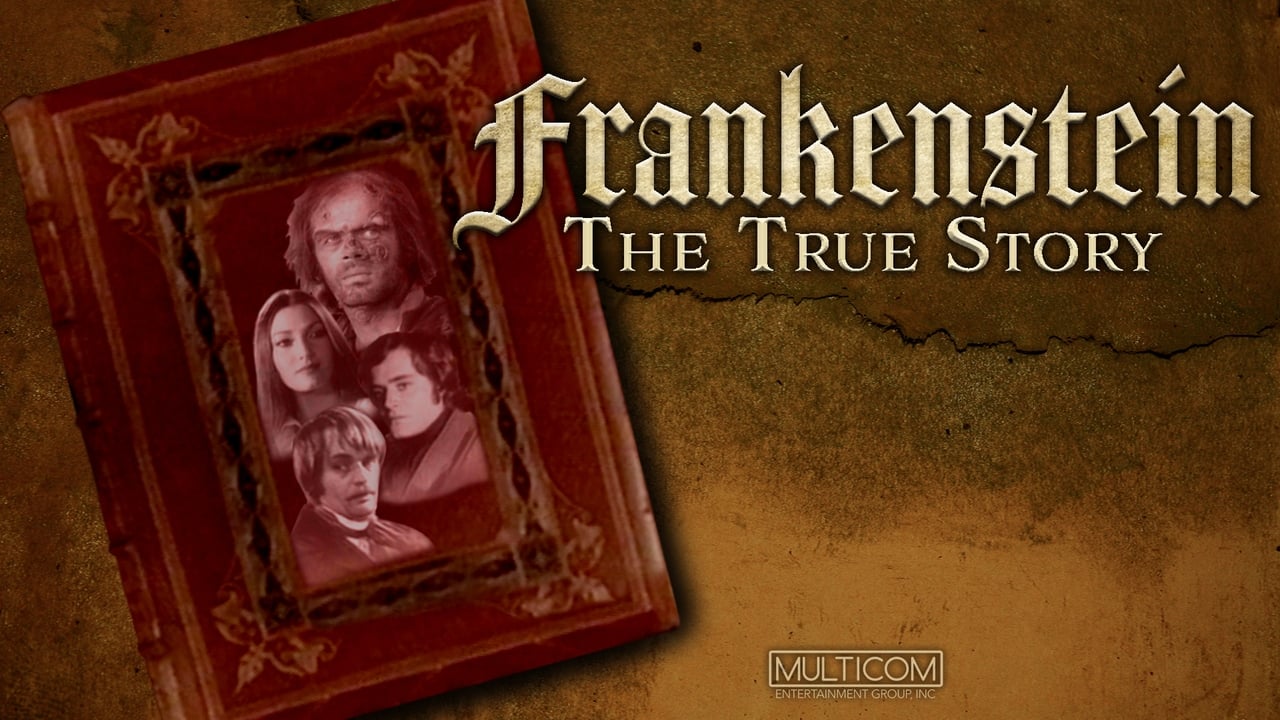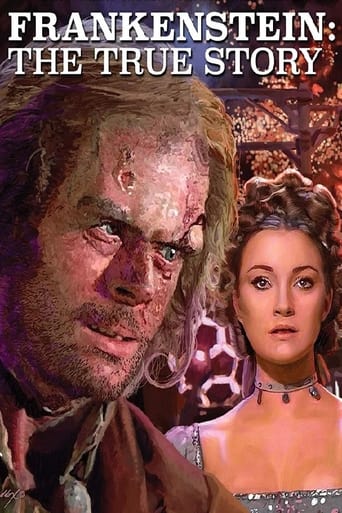

Best movie of this year hands down!
... View MoreJust perfect...
... View MoreIntense, gripping, stylish and poignant
... View MoreIt is interesting even when nothing much happens, which is for most of its 3-hour running time. Read full review
... View MoreDo not let this one fool you. This NOT a faithful adaptation of Mary Shelley's novel. The very idea that the Frankenstein creature is decomposing contradicts that the creature was given life. He's alive, not just reanimated dead tissue, that's a major point in the story. It's a disappointing and senseless twist that is completely unnecessary. If you want a version of Frankenstein that actually follows Mary Shelley's novel check out the version produced by Hallmark and released to DVD by Lion's Gate starring Luke Goss as the creature. That mini-series version of Frankenstein from 2004 is the most faithful to the book.
... View MoreThis version of Frankenstein was shown on television in two parts back in 1973. The film starts with a prologue by James Mason that was, for the most part, completely unnecessary. In addition, it shows various clips of the movie that tend to ruin the film to a degree. My advice is skip this and go right to the film.As for the title, it implies that this is closer to Mary Shelley's original story and in most ways it is closer than other versions---in particular, the famous 1931 version. However, while much closer, a lot of additional material was added and by the two hour mark, it really deviates into a strange direction indeed. I really wish someone would make a version EXACTLY like the book, but so far I have no knowledge of anyone who has done this. The biggest difference the original tale and films have is that the films always spend a lot of time on how the Doctor created his monster--whereas in the book, there's very little about this. Instead, the book emphasizes the lack of responsibility the creator plays towards his creation--the true purpose of the novel. And, fortunately, this movie does focus on this quite a bit...as well as the creation of the monster.As for the "monster", an interesting choice was made for this film. Instead of the usual hideous man covered in stitches, the producers decided to hire handsome leading man Michael Sarrazin for the role. Initially, he is a very handsome creation--receiving the admiration of others. However, in a very interesting twist, the creation begins to decompose and morph slowly--and then becomes the hideous creature. I liked this approach--as it was very novel and offered something different.As the man begins to decompose and lose his prettiness, at the same time you slowly see the Doctor become more and more distant from his creation--losing his temper and treating him shabbily. Frankenstein's acting like a jerk is excellent--and more in keeping with the novel--something often forgotten in other versions of the story. In other words, the creation becoming a monster was the result of his being rejected by his creator--not just because he was ugly--though the rejection was not as complete here as in the book.On his own, the monster is befriended by a blind guy (Ralph Richardson) and this ends in the tragic deaths of his family. For some odd reason, the monster wants the now dead daughter of Richardson (Jan Seymour) to be brought back to life. But, for an even odder reason, instead of taking him to Frankenstein, he brings him to Mason who has been wanting to make his own undead freak. This portion of the film is as far removed from the original story as you can get and the film only gets back to the original story after the whole "Dr. Polidori" segment is complete.It turns out that Mason was an evil mad scientist (unlike Frankenstein who was just a misguided and irresponsible mad scientist), as he decided to use Sarrazin for his own end--to force Frankenstein to help him make another, and hopefully better, creation using the body of Seymour (among others). After the newest creation comes to life, there is an extended portion of the film involving Seymour--who is a bit of a conniving nympho and nutter! It's as if Seymour is doing a warm-up for her later role in the TV mini-series "East of Eden"! Now, following an attempt by Polidori and Frankenstein to murder the creature, it's no wonder that Sarrazin's character goes insane and starts to do bad things!! How this ends comes as a rather nasty surprise, that's for sure! But, as I said before, none of this bears any resemblance to the original novel and it all seems a bit histrionic.Now, after two and a half hours, the film finally returns to the book's plot--consisting of a drawn-out portion where the creation goes about destroying the life of his creator. Ultimately, it takes the film to the Arctic for a final showdown--something few movies ever bothered to do, but which was an important part of Shelley's story.Overall, it was a very enjoyable and lavish film. Unfortunately, it also was NOT the "true story" it purported itself to be, as at times it bore little semblance to Shelley's novel.Interestingly, 1973 was a banner year for made for TV Frankenstein films (in addition to the freaky Andy Warhol version). In addition to this film, "Wide World Mystery" (ABC) also made their own version that lacked the budget and cast this film had, but which had a much more interesting and sympathetic monster--and, in my opinion, was a better film. I say that you should see them both, though, as they are both very well made in their own way.By the way, there were a few goofy moments in the film despite it being a pretty good movie. First, watching human limbs retain 'memories' and have the ability to crawl about independently was pretty stupid. It may have looked neat, but just made me groan. Second, the hypnosis scene with James Mason and Agnes Moorehead was also pretty silly--no one can hypnotize anyone like this! Third, while Michael Sarrazin's creature was not too pretty later in the film, he was not THAT ugly and people's reactions to him seemed pretty absurd. I especially laughed when Agnes Moorehead saw him and had a fit and died!!! Talk about silly! And the lightning bolt turning Polidori into an instant skeleton! Ha!
... View MoreFull-blooded telling of the Frankenstein story manages to be fresh and original and sustains its running time. There are several terrific performances and possibly the most sympathetic, tragic portrayal of the monster ever by Michael Sarrazin. Dr. Henry Clerval (David McCallum) enlists the services of brilliant surgeon Dr. Victor Frankenstein (Leonard Whiting) to help him create a human being from body parts. As everybody knows, the experiment hits a hiccup and "The Creature" goes bananas. But when Dr. John Pilodori (James Mason) steps up to the plate to construct a second creature with Frankenstein's aid, the drama hits its stride and all hell breaks loose. Some of that "hell" is the understandable anger of Frankenstein's bride (Nicola Pagett), who is forced to spend her wedding night alone while hubby is busy giving life to dead things in his hillside lab. Mason is incredible as the obsessed, insane Polidori, the film's true villain, and does a good job of making us (the audience) loathe the very sight of him. Pagett is strong as the frustrated but devoted wife, and Whiting is a memorable Frankenstein. Also worthy of praise is Ralph Richardson who breathes much life into the role of the Blind Hermit. Sarrazin, however, is a revelation as the decaying, angry, emotionally distraught experiment gone wrong. Because we have seen him proud and happy, it is horrible to watch him physically disintegrate and become persona non grata in the Frankenstein lab. During the creation of Jane Seymour's "Bride", it was devastating to see the dejected Sarrazin witnessing the process, knowing his time had already come and gone. Later, the scene in which he crashes a party and beheads a key character is a classic horror moment and manages to be emotional and grotesque. Aside from the last scene, which has an inexplicable abruptness to it, this is a fantastic Frankenstein adaptation.
... View MoreA two part television movie which claimed to tell, for the first time anywhere, the genuinely faithful tale of the man who made a creature, exactly as its writer, teenaged Mary Shelley, first concocted it. Well, it may be helpful going in to be forewarned that this isn't really the "true story," but it comes close and what matters most is that it's a good film, albeit one that's three hours long.In this version, young Victor Frankenstein (Leonard Whiting) is a medical student thirsting for knowledge, which he gets from the wildly eccentric Dr. Henry Clerval (David McCallum). Clerval has devised a method of restoring dead insects back to life, and his greatest achievement comes when he reanimates a man's severed arm. Frankenstein teams up with Clerval and they are just about to proceed with the ultimate experiment of assembling a complete man from dead bodies and making it live, when Henry dies and Victor is forced to work alone (I'll bet you never knew it wasn't all Frankenstein's idea). The final product is a perfectly attractive male creation (Michael Sarrazin) who has been given Clerval's brain and instantly bonds with Victor, his creator. Frankenstein begins to neglect his fiancé Elizabeth (Nicola Pagett) while taking the time to refine his new Adam. Unbeknownst to Victor, before Clerval died he tried to warn Frankenstein that the animation process performed on the first severed arm was actually reversing itself and the flesh was deteriorating. In a short period of time, the once-handsome creature begins to show signs of his skin rotting and upon witnessing this, Frankenstein suddenly loses all interest in his creation and abandons him. The rest of the film carries on with the scorned monster's journey to punish his master. He meets up with a nasty and cunning former associate of Clerval, the elder Dr. Polidori (James Mason), who blackmails Frankenstein into constructing a female named Prima (played by Jane Seymour).This is a lush and well-crafted Victorian period piece, and the story of unrequited love between the creature and his creator is at the core of it. For those who up till now have only been familiar with the classic Boris Karloff image of the flat-headed monster with big boots and bolts in his neck, this is something else entirely. It's touching but also horrifying at times, with a good cast. In addition to Michael Sarrazin's sympathetic work as the creature, David McCallum's obsessive Clerval and James Mason's unscrupulous Polidori (presumably the Ernest Thesiger character in this one) are the best performances. *** out of ****
... View More